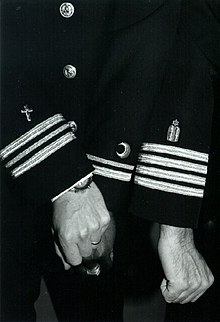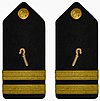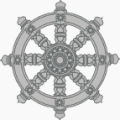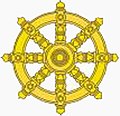
A | B | C | D | E | F | G | H | CH | I | J | K | L | M | N | O | P | Q | R | S | T | U | V | W | X | Y | Z | 0 | 1 | 2 | 3 | 4 | 5 | 6 | 7 | 8 | 9

Religious symbolism in the United States military includes the use of religious symbols for military chaplain insignia, uniforms, emblems, flags, and chapels; symbolic gestures, actions, and words used in military rituals and ceremonies; and religious symbols or designations used in areas such as headstones and markers in national cemeteries, and military ID tags ("dog tags").
Symbolism sometimes includes specific images included or excluded because of religious reasons, choices involving colors with religious significance, and "religious accommodation" policies regarding the wear of "religious apparel" and "grooming" (such as "unshorn" hair and beards worn for religious reasons) with military uniforms. Additionally, military chaplains themselves are sometimes regarded as "symbols of faith" for military personnel who face challenges to their faith and values.[1]
Chaplain insignia by military service
Army




On July 29, 1775, the Continental Congress established the military chaplaincy, but chaplains did not wear insignia until 1880.[2] However, in 1835 Army Regulations prescribed black as the branch color for chaplains, directing that a chaplain wear a black coat.[2] By 1861, US Army Regulations included the details that the chaplains should wear a single breast officer's frock coat made of black wool, with black cloth covering the buttons, and no shoulderboards.[3] In 1864, the Army Uniform Board "enhanced" the frock coat by adding black "herringbone braid" in across the chest at the buttons and buttonholes, with buttons still covered in black.[3] This coat was used by army chaplains until 1880, when shoulder boards were authorized for chaplains for the first time, and the first official insignia was introduced.[3]
Although the Latin cross has long been the symbol for the majority of United States military chaplains, this first official chaplain insignia was the "shepherd's crook" (staff).[4] Authorized in General Order Number 10, and remaining in force for the period February 13, 1880 – May 5, 1888, it was described as "embroidered frosted silver bullion in center of black velvet shoulder straps, and was considered appropriate for both the frock coat or undress uniform."[4] The plain "Latin cross" (silver on dark-blue shoulder straps) became the authorized chaplain insignia in 1898, replacing the shepherd's crook.[4] Today, despite the fact that the shepherd's crook is no longer used as an insignia for individual chaplains, it is included in the design of the Chaplain Corps regimental insignia in honor of its place in Army Chaplain Corps history.[5]
Jewish chaplains were first authorized to serve during the Civil War, but it was during World War I that the issue of insignia reached the army, when Congressman Isaac Siegel from New York petitioned the army that rabbis serving in uniform be permitted to wear "some other insignia in place of the cross."[6]
Within two weeks of receiving this request, the army issued a directive stating that "Objections having been made to Jewish Chaplains wearing the prescribed insignia, you are authorized by the Secretary of War to omit the prescribed insignia" (the cross).[7]
However, after battlefront reports indicated that difficulties arose from the fact that Jewish chaplains wore no insignia, the army began to look into various proposals, including a continuation of the practice of having Jewish chaplains wear no insignia, to the creation of a separate insignia for them, to a return to the shepherd's crook as a shared symbol for all chaplains.[6] General Henry Jerver, acting assistant chief of staff for the army favored the third alternative, and within weeks of his decision this became the official policy for the Army.[6] However, many Christian chaplains opposed this change of policy, and in August 1918 General Pershing cabled the War Department to inform it of this opposition.[7] Not all Christian chaplains opposed the idea of a universal symbol, and some went on record agreeing with the statement of one chaplain that "I am a chaplain of the Christian faith, but I welcome the change. The shepherd's crook is symbolic of the chaplain's work."[8]
Returning to a consideration of the three options of no insignia for Jewish chaplains, a shared insignia, or a separate insignia, the army opted for a separate Jewish chaplain insignia that included an image of the two tablets of the Ten Commandments, using Roman numerals to indicate the commandments, with a small six-pointed Jewish star on top of the tablets.[6] Other symbols considered included a six-pointed star (hexagram), which was rejected by the army because it could too easily be confused with the 5-pointed star worn by generals; a seven-branched candelabra (Menorah); and two "Lions of Judah" supporting the six-pointed star.[6]
This symbol would remain the insignia for Jewish chaplains until 1981, when the navy changed its insignia to include the first ten letters of the Hebrew alphabet—to replace the Roman numerals—and both the army and the air force followed suit.[9][10] While the official change to Hebrew letters became official November 9, 1981[11] Jewish chaplains were not required to make the uniform change until January 1, 1983.[12]
Insignia decisions for chaplains representing faith groups other than Christianity and Judaism have not been made unilaterally by the army, but instead have been joint decisions for all military chaplains.
The Continental Navy, predecessor of the United States Navy, was approved by the United States Congress on October 13, 1775, with navy regulations (adopted November 28, 1775) that included as its second article: "The Commanders of the ships of the thirteen United Colonies are to take care that divine service be performed twice a day on board, and a sermon preached on Sundays, unless bad weather or other extraordinary accidents prevent." But, while the need for navy chaplains was recognized from the beginning, attitudes and policies toward navy uniforms or insignia for its chaplains went through many changes before final decisions were made.[13] 1847 navy regulations did authorize chaplains to wear a blue uniform with black collar and cuffs with no insignia, and later, in 1864, chaplains were provided the same uniform as other staff officers, with the use of a silver cross as a corps device.[13]
However, regulations for navy chaplain uniforms and insignias changed a number of times over the following years: 1869–1876, when chaplains were considered as officers without rank, they wore the cross without any additional "sleeve lace"; in 1876, uniforms were no longer authorized for chaplains, who were to wear either civilian clothing or the vestments appropriate to their faith group; in 1883, the uniform became an option for chaplains, with the cross; and then in 1894, the epaulets and passants were removed so that chaplain uniforms had no insignia at all, neither any that indicated they were officers nor even the cross signifying that they were chaplains.[13]
It was not until 1905 that the navy uniform code included a permanent regulation for chaplains: along with ranks equivalent to line officers, they were to wear naval officer's uniforms with the sleeve braid in "lustrous black" (not gold, like that of other officers), and to wear both the officer rank insignia and a gold cross.[13] In 1918, naval staff corps rules were changed, and the distinctive black braid of chaplains was replaced by the same gold braid worn by other officers, along with the Latin cross.[13]

The navy policy on insignia for Jewish chaplains was not resolved as quickly as it was in the army. When Rabbi David Goldberg entered the navy October 30, 1917,[14] receiving orders after basic training to report to the USS President Grant, he asked a senior chaplain about the fact that he was told to wear the Latin cross, receiving the response that "the men understood that he wore the insignia of the corps and not his faith group."[6] Goldberg wore the cross throughout the time he served on the ship, but after reporting to his next assignment ashore the combination of his shipboard experience and the number of letters he received from rabbinic colleagues objecting to his wearing a cross finally led to his petitioning the navy in 1918 to allow him to wear the Star of David instead.[6]
When Goldberg's request to wear the six-pointed star was rejected—based on the same fears the army had that a six-pointed star would be too similar to the five-pointed star worn by flag officers—he recommended the shepherd's crook as a universal symbol, a recommendation that met with opposition from many Christian chaplains.[6] However, the Navy did authorize Goldberg to wear that symbol himself, in place of the cross.[6][13] Goldberg wore this insignia until the end of World War II, when navy policy eventually changed to allow navy Jewish chaplains to wear the tablets and the star, the same insignia worn by Jewish chaplains in the army.[6] This change took place in 1941,[13] after only two Jewish chaplains (Goldberg and Harold Strauss) had worn the Shepherd's Crook insignia.[15]
Although the shepherd's crook has not been used as a chaplain insignia since that time, the term used for the active duty chaplain with the earliest appointment is the "Gray Shepherd."[16]
As in the case of the army, decisions about chaplain faith group insignia after those made regarding Jewish chaplains (the original decision and the later decision to change Roman numerals to Hebrew letters) have not been made unilaterally by the navy, but instead have been joint decisions for all military chaplains.
Marine Corps and Coast Guard
Navy chaplains also serve Marine Corps,[17] Coast Guard,[18] and Merchant Marine.[19] Although they have the option of wearing marine corps or coast guard uniforms when assigned to their respective units, the chaplain corps insignia remain that of the navy.[20][21]
Merchant marine

The United States Merchant Marine is a civilian auxiliary of the United States Navy, but in accordance with the Merchant Marine Act of 1936 its members are considered military personnel during times of war when the merchant marine comes under the navy. Until World War I, merchant mariners did not wear uniforms, but they were introduced in 1919, because "young Americans now entering the merchant service have more regards for themselves and their job when wearing a uniform, and that the merchant sailor commands greater respect when ashore, either at home or in foreign ports, if in uniform.[22] The uniform introduced in 1919 was based on U.S. Navy uniforms with enough differences to distinguish between the two services, including wreaths for officers on cap and sleeve insignia and shoulder boards.[23] Chaplain insignia with the wreaths were created around 1943, at a time when merchant marine officers were drawn from the civilian population, including many retired coast guard and navy officers.[23] Today, when active-duty Navy chaplains serve with the USMM, such as the two stationed at the United States Merchant Marine Academy, they wear standard navy uniforms and insignia[24]
Air Force
On July 28, 1942, Chaplain Charles Carpenter was appointed to the newly created position of air chaplain for the Army Air Force, within the larger United States Army organization. Later, when the United States Air Force was established as a separate service on September 18, 1947, the original plan was that chaplain support would continue to be provided by Army chaplains. However, on May 10, 1949, the decision was made that the still new branch of the military would have its own chaplains. At that point, chaplains serving with the Air Force began to wear Air Force uniforms, but continued to use the same Jewish and Christian Chaplain Corps insignia that had been used by the Army. In 1981, when the Navy approved the change to the Jewish chaplain insignia, from Roman numerals to Hebrew letters, both the Army and Air Force made the same change soon thereafter. Since then, the approval of insignia to represent chaplains of other faith groups has been made jointly by of all branches of the United States Armed Forces. However, while the designs for the insignia are the same for all services, the Air Force categorizes the insignia as "occupational badges," with different "wear use" rules than the other services.[25]
Additionally, while the Civil Air Patrol chaplain program is a separate organization than the USAF Chaplain Corps, it was established in 1950 under the guidance of the Air Force chief of chaplains and "is modeled after the Air Force Chaplain Service," and follows the same rules for faith group insignia.[26]
Chaplain insignia by faith group
Christian

Other than the short period 1880–1888 when all army chaplains wore the Shepherd's Crook, the Latin cross (also referred to as the "Christian cross") has been the symbol for all Christian chaplains, regardless of denomination, although in some other nation's military forces, separate symbols are used for some Catholic, Eastern Orthodox, and Protestant chaplains, and sometimes for specific groups within the larger Protestant faith group, such as Calvinist chaplains, and the United States Department of Veterans Affairs includes a number of different denominational versions of the cross on gravestones in veterans cemeteries.[27]
Some Christian groups, like the Church of Jesus Christ of Latter-day Saints (LDS Church), do not normally use the symbol of the cross—but do accept it as the uniform insignia for Christian military chaplains.[28] So for example, the LDS Church teaches that its members "remember with reverence the suffering of the Savior. But because the Savior lives, we do not use the symbol of His death as the symbol of our faith," and therefore "The only members of the Church who wear the symbol of the cross are Latter-day Saint chaplains, who wear it on their military uniforms to show that they are Christian chaplains."[29] Similarly, because the cross is not normally a symbol used by the Unitarian Universalist Church (UU), an article on military chaplains written for members of that religious group had to explain that "UUs in the military are considered Protestants, and wear crosses."[30]
Messianic Jewish question
In 2008, Michael Hiles, a clergyman reporting for training as a Navy chaplain candidate identified himself as a Messianic Jew (a Jew who accepts Christian theological views regarding Jesus, including the changes to Judaism such beliefs entail), requesting that he still be permitted to wear the insignia of a Jewish chaplain.[31] The November 26, 2008 decision from Vice Admiral Mark E. Ferguson, president of the Navy Uniform Board and Deputy Chief of Naval Operations for Manpower, Personnel, Training, and Education, was that Hiles would be required to wear the cross linked to his Christian (and non-Jewish) faith beliefs.[31] Given the choice of wearing the cross or given the right to withdraw from training, he chose the latter.[31]
-
Christian military chaplain insignia, Army
-
Christian military chaplain insignia, Navy
-
Christian military chaplain insignia, Air Force
Jewish

The Jewish chaplain insignia made up of two tablets of the Ten Commandments, with ten Roman numerals symbolizing the commandments, and with the six-pointed Star of David above the tablets, was adopted for Jewish army chaplains in 1917, and for Jewish naval chaplains in 1941. The original Army description did not specifically reference a star per se, but instead read "a double Tablet bearing numerals from I to X, surmounted by two equilateral Triangles interlaced."[32]
Before the tablets-and-star design was approved for United States Navy Jewish chaplains, only two Jewish chaplains wore the Shepherd's Crook insignia: Chaplain David Goldberg, during WWI, and Chaplain Harold Strauss, 1931–1941.[15] Beginning in 1917, Goldberg first wore the cross—the original symbol for all navy chaplains—until receiving permission to wear the Shepherd's Crook instead.[6]
On August 5, 1980, Navy Chief of Chaplains Rear Admiral Ross Trower convened a blue ribbon panel made up of Jewish chaplains to consider the "beneficial suggestion" made to the Navy to change the Roman numerals to Hebrew letters.[33] The question had been raised before and not all Jewish authorities were in favor of the change because of the concern that the insignia might be considered "holy"—"even mildly holy"—because of the presence of Hebrew writing.[33] In fact, in a 1972 responsum from the National Jewish Welfare Board authored by Rabbi Solomon Freehof, he recommended maintaining Roman numerals although he did state that when it came to using Hebrew letters simply to indicate numbers, "there is no strict law against it."[33] Nevertheless, based on the panel's unanimous 1980 recommendation to make the change, Chaplain Trower made the formal recommendation to the President of the Navy Uniform Board that the Navy should make the change unilaterally, without the additional time that would be required for all services to study the question.[33] Included in his recommendation was the statement that
The Jewish Chaplain Corps device as it now appears, with Roman numerals representing the Ten Commandments, has been worn with pride by all previous and present Jewish chaplains. It is felt, however, that a change to Hebrew characters at this time would be unanimously and enthusiastically received by Jewish chaplains and Jewish personnel as a source of still greater pride, reflecting as it would a more significant and authentic representation of a heritage and faith eternally related to Hebrew as the language of the Old Testament and the prophets[33]
The President of the Navy Uniform Board approved the change on December 17, 1980,[33] with the army and air force quickly approving the change as well. (Note that the Roman numeral version read left to right, with the first five numerals on the left tablet and the second five on the right;[34] the Hebrew reads right to left, with the first five numerals on the right and the second five on the left, as per Jewish tradition. Jewish tradition states that the tablets had flat tops and may even have been square instead of rectangular, but the Christian-influenced rectangular tablets with round tops is nonetheless very frequently found in Jewish art and synagogues, and was not objected to here either.) The new insignia was authorized for wear from 1981, with a grace period authorized to allow Jewish chaplains to make the required uniform changes by January 1, 1983.[12]
- Jewish chaplain insignia
-
Shoulder boards with "shepherd's crook," the first specific United States Navy Jewish chaplain insignia.
-
Former Jewish chaplain insignia, with Roman numerals
-
Former Jewish chaplain insignia, with Roman numerals
-
Army
Current Jewish chaplain insignia, with Hebrew letters -
Navy
Current Jewish chaplain insignia, with Hebrew letters -
Air Force
Current Jewish chaplain insignia, with Hebrew letters
Muslim
On December 14, 1992, the Army Chief of Chaplains requested that an insignia be created for future Muslim chaplains, and the design (a crescent) was completed January 8, 1993.[11][12]
-
Muslim chaplain insignia, Army
-
Muslim chaplain insignia, Navy
-
Muslim chaplain insignia, Air Force
Buddhist
In 1990, the Army made the decision to create an insignia for future Buddhist chaplains, and the Armed Forces Chaplains Board (the board made up of the three Chiefs of Chaplains and active-duty Deputy Chiefs of Chaplains for the Army, Navy, and Air Force) began working with the Army's Institute of Heraldry.[12] The design was completed in August 1990, representing the dharmacakra (the "wheel of dharma" or sometimes, "wheel of law"), an eight-spoked wheel "representative of religious observances."[12]
-
Buddhist military chaplain insignia, Army
-
Buddhist military chaplain insignia, Navy
-
Zdroj:https://en.wikipedia.org?pojem=United_States_military_chaplain_symbols
Text je dostupný za podmienok Creative Commons Attribution/Share-Alike License 3.0 Unported; prípadne za ďalších podmienok. Podrobnejšie informácie nájdete na stránke Podmienky použitia.
Antropológia
Aplikované vedy
Bibliometria
Dejiny vedy
Encyklopédie
Filozofia vedy
Forenzné vedy
Humanitné vedy
Knižničná veda
Kryogenika
Kryptológia
Kulturológia
Literárna veda
Medzidisciplinárne oblasti
Metódy kvantitatívnej analýzy
Metavedy
Metodika
Text je dostupný za podmienok Creative
Commons Attribution/Share-Alike License 3.0 Unported; prípadne za ďalších
podmienok.
Podrobnejšie informácie nájdete na stránke Podmienky
použitia.
www.astronomia.sk | www.biologia.sk | www.botanika.sk | www.dejiny.sk | www.economy.sk | www.elektrotechnika.sk | www.estetika.sk | www.farmakologia.sk | www.filozofia.sk | Fyzika | www.futurologia.sk | www.genetika.sk | www.chemia.sk | www.lingvistika.sk | www.politologia.sk | www.psychologia.sk | www.sexuologia.sk | www.sociologia.sk | www.veda.sk I www.zoologia.sk














